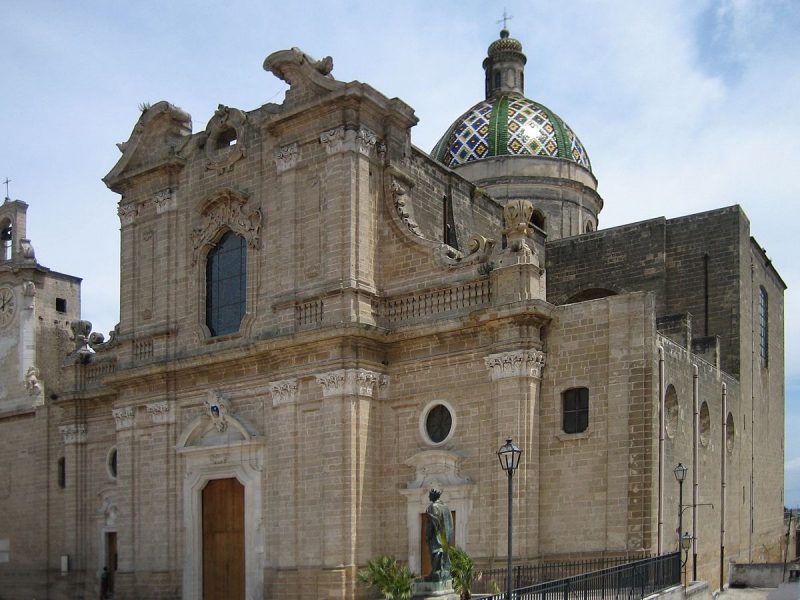The Borgo of Ostuni
Ostuni is a point of light nestled in the green of the olive groves, glowing and white, high above the sea. Its pale brilliance juts out over the Karstic stone of the Murge, one of the stones used in the stone walls and the cone-shaped trullos of the Valle d’Itria.
The houses seem to be facing the sky, gazing up at the cross on the bell-tower of the Cathedral: the only touch of nude stone among the white-washed dwellings. Ancient city walls surround the borgo, in an expression of profound love for this little city that teems with life. Over time, these faithful custodians have become an integral part of the borgo, joining the town in an indivisible union.
Saint Oronzo is found in the center of the city, smiling down from his column, enjoying the amazement of the tourists, who are incredulous that a place like this even exists, an entire town as white and gleaming as the rays of the moon.
Walk, walk, walk: Ostuni invites you to walk! The little streets and narrow lanes all call out to be explored, and every hidden corner reveals a new, ecstatic discovery, in a mosaic of colorful artisan shops interspersed with the tempting aromas from the little restaurants. Whoever comes to Ostuni asks the same question, “How can any place be so perfect?” Because Ostuni has everything, truly everything, even the sea, whose waves can be seen shining below, from on high in the historical center.
History
Ostuni is set among three hills facing each other on a high plane, surrounded by secular olive trees.
Its territory has been populated since the Prehistoric period, but before becoming one of the most beautiful cities in Italy, it had to pass through many dark centuries. It was inhabited by the populations of the Iapiges, the Messapians, and finally the Romans, who remained in this land until 488 A.D., when Ostuni fell into the hands of Theodoric the Great of the Visigoths. During this period, the city was stripped of an immense artistic patrimony, which was moved from the Byzantine churches of Ostuni to Ravenna, the Visigoth capital. This is only the first of a series of violations the city was forced to submit to. The arrival of other barbarians inflicted further cruelty and worse atrocities, which Ostuni wearily endured until the Medieval period.
The Middle Ages offers Ostuni a period of relative tranquility, but the power struggles of the various noble families continue to destabilize the city. The Normans arrive, and then the Swabians, who bring a fresh wind of culture to the southern peninsula. In 1266, Manfredi, the son of Federico II of Swabia, Holy Roman Emperor, is defeated by the Angevins. The head of this new dynasty is King Charles of Anjou, whose presence in the south was encouraged by Pope Clemente IV, concerned about the Imperial presence of the Swabians in the territory.
The Angevin presence in Italy initiates a period that Dante Alighieri called “la mala signoria”, ‘the bad nobles’, three words to describe more than a century of an extremely oppressive ruling class.
Centuries later, during the Italian Risorgimento, Ostuni was animated by the Carbonari, a revolutionary group, which led to the city to open a branch of Giuseppe Mazzini’s Giovine Italia movement, whose primary goal was to transform Italy into a Republic. On June 26, 1860, Ostuni was the first city to take down the symbols of the Bourbon rulers, destroying effigies and crests and setting up a temporary government. The Bourbons sent their troops to re-conquer the city, but Ostuni resisted with courage and determination, and after centuries of foreign domination, finally obtained liberty for the city. Later, during the Fascist period, investments in construction of new public buildings were made.
The post-war period brought an influx of social and economic renewal, transforming Ostuni into one of the ‘Centers of Excellence’ in Puglia.
The Cathedral of Ostuni
La Cathedral of Ostuni was built on the highest point of the city. After an earthquake in 1743 damaged the borgo, the Cathedral was reconstructed anew.
The façade is in Late Gothic style, with unique curves that accent the three portals. The intricately carved rose window over the central door is one of the largest in the world, and full of Medieval symbolism. Its twenty four rays converge in the center, where the figure of Christ stands, surrounded by cherubs and the faces of his disciples.
The interior is in the Latin Cross layout, characterized by an archway with five columns dividing the space into three naves. The central nave is covered with glorious paintings from the 1700’s depicting the life of Jesus, St. Oronzo and St. Biagio.
“Guglia di Sant’Oronzo” The Column of St. Oronzo
St. Oronzo became patron of the city after protecting the population from an epidemic of the Plague. The statue was placed in the center of Piazza Liberta’ as a gesture of eternal gratitude to the saint, who has watched over the city for centuries from high on his ornate column.
The “Guglia di Sant’Oronzo” is the essential symbol of Ostuni, created by Giuseppe Greco in 1717, sculpted in local stone in the Baroque style. Sant’Oronzo is depicted in the act of blessing the city, with other saints featured lower down the column, including St. Biagio and St. Irene. The inscriptions on the column recount a vow to the saint made by Ostuni’s grateful population.
The City Walls
During the period of Federico II, fortified city walls were constructed around the borgo of Ostuni, which were then strengthened between 1400 and 1500, and then gradually incorporated into the urban structure of the borgo.
In 1743, an earthquake damaged the town and also a substantial part of the walls. What remained was transformed into civil habitations, utilizing the change in zoning to restore the eight remaining defensive towers.
Of the city gates, only two survived the earthquake, Porta Nova and Porta San Demetrio.
Porta Nova is on the western side of the town, facing the marina of Ostuni. Built in XV century to replace the previous gate, it is evidence of the heavy urbanization that developed around the Norman castle in that period.
Porta San Demetrio is on the eastern side of the town, toward the road for Brindisi. It is the most ancient gate in the city, dating back to the Medieval period.
The Museum of Pre-Classical Civilizations of the Southern Murge
The territory of Ostuni has been inhabited since the Stone Age, and there have been innumerable archeological and paleontological findings discovered here over the centuries. To harbor and exhibit this treasure trove, the Museum of Pre-Classical Civilizations of the Southern Murge was founded.
The museum is located in the ex-Carmelite Monastery of Santa Maddalena dei Pazzi. Initially it held artifacts found exclusively in Ostuni, but its patrimony was later increased by historical relics discovered all around the territory of the Murge.
Through its artifacts, the museum of Ostuni recounts a story that began approximately twenty-eight thousand years ago, and within its walls it conserves the human fossil of the of the first mother in the world.
Ostuni, The White City
Ostuni, is set like a jewel between three hills, a white point of light that gleams bright from afar.
The candid white of its historical center comes from the practice of white-washing the houses with lime-stone plaster, a material that was abundant and inexpensive during the Middle Ages.
In 1657, an epidemic of the Plague struck all the small villages surrounding the hills, with the dead falling like soldiers in combat. Only Ostuni was spared being decimated by the catastrophe. The population attributed the miracle to St. Oronzo, but it was surely the disinfectant qualities of lime-stone that saved the city.
“La Cavalcata di Sant’Oronzo” St. Oronzo’s Ride
Since 1657, the population’s devotion to St. Oronzo has been a part of the history of this borgo. Every year, in celebration of their patron saint, Ostuni pays homage to the miracle they received during the terrible Plague. On the 26th of August every year, the faithful join in a procession to the Sanctuary of the saint, place the papier-mache statue that represents him on their shoulders, and carry him through the city, escorted by a pageant of knights-in-armor in full regalia on horseback. The stone streets and lanes fill with brilliant colors and lavish decorations, all in honor of this timeless tradition known as “La Cavalcata di Sant’ Oronzo”, St. Oronzo’s Ride.
The Most Ancient Mother in the World
‘Delia’, a delicate name that holds a mighty spirit. The paleontologist Donato Coppola gave this name to the woman he discovered in 1991, a woman who had been resting there for twenty-eight thousand years. She was found as if she had been sleeping, with one hand under placed under her head and the other resting protectively upon her pregnant womb. Nestled against her, the tiny bones of an eight month old fetus, who for thousands of years had rested there, with his little hands over his eyes, as if hiding. A simple domestic scene, wrapped in gestures of love and life, this is how she came through time to reach us: Delia, the most ancient mother of the world.
Next to her, the remains of a man buried thirty thousand years ago were found, together with another man who had been in poor health, buried thirteen thousand years ago.
Delia had been just over twenty, a young and robust woman with all her teeth, which were healthy but worn down, probably from chewing pelts to make leather for clothing.
Near her wrist, shells were found, together with a conch, ancient symbol of rebirth. Also symbolizing rebirth is the red color of her head cover, a cap made of over 650 shells interwoven with eighty deer teeth.
Delia and her child were discovered in the cave of Santa Maria di Agnano, where today you can visit the place they were resting until 1991, and admire the diorama, a life-like historical model of what she must have looked like. Delia’s actual remains and the remains of her fetus are preserved in the Museum of Pre-classical Civilizations of the Southern Murge.
Andrea Iaia
Andrea Iaia è un giovane attore italiano nato ad Ostuni il 9 agosto 1982. La sua formazione ruota attorno alle lezioni di alcuni docenti dell’Actor’s studio di New York. Nella sua storia cinematografica è stato uno dei protagonisti del film “20 sigarette”, che è stato premiato al Festival del Cinema di Venezia, ma soprattutto ha interpretato Primo Carnera nel film Carnera- The walking mountain, diretto nel 2008 da Renzo Martinelli.
Giovanni Semeraro
Giovanni Semeraro è stato un grande amante dei libri e degli studi, nato ad Ostuni nel 1911. La sua carriera, prima di docente e poi di bibliotecario e filologo, gli ha consentito di analizzare da vicino la lingua e la cultura indoeuropea e di formulare una tesi insolita. Il professor Semeraro sosteneva che le lingue indoeuropee sono di provenienza mediterranea e direttamente collegabili al ceppo semitico.
Come bibliotecario è stato a capo di importanti biblioteche nazionali, a Firenze in particolare ha diretto prima la Biblioteca Riccardiana e successivamente, per un breve periodo, la Biblioteca Medicea Laurenziana.
Nel corso della sua vita ha pubblicato numerosi volumi, le sue opere più importanti sono due dizionari e i testi ‘Le origini della cultura europea’, ‘L’Infinito, un equivoco millenario’ e ‘Il popolo che sconfisse la morte. Gli Etruschi e la loro lingua’.
Per la sua intensa attività culturale è stato insignito di importanti onorificenze, tra cui la targa d’argento della regione Toscana e il premio Bel San Giovanni.
Si è spento a Firenze, il 20 luglio del 2005.
Conosci ricette tipiche di questo borgo? Contattaci!

 Italiano
Italiano
 Deutsch
Deutsch




















